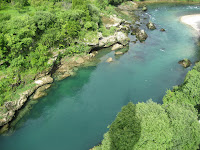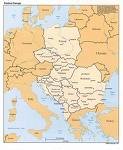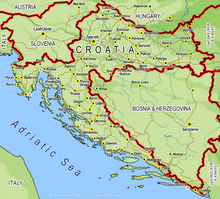
And by night

The Old Bridge of Mostar in Bosnia-Hercegovnia spanned the fast-moving Neretva river for hundreds of years, connecting communities on either side. It was a symbol of trust, cooperation, beauty, and connection.
 The Neretva river has the most amazing colors and flow. It seems like a liquid emerald city, coursing along on its way.
The Neretva river has the most amazing colors and flow. It seems like a liquid emerald city, coursing along on its way.  It is so beautiful that you could watch the water for hours, and indeed I did just that.
It is so beautiful that you could watch the water for hours, and indeed I did just that.Here is a tiny waterfall cascading in to the water. You can't see the green color of the water so much in this one because it is still so early in the morning and the sun isn't hitting the river yet, but you can imagine it.

OK... here is some history for those of you who do not remember, never knew in the first place, or were not old enough to watch the news in 1993...
During the war in the 1990s, Mostar was very hard-hit, especially during 1993 when it was shelled, hit by tanks and artillery fire for months on end. There is still a lot of damage to the town, the buildings, and Mostar was one of the areas in which there was the most architectural damage (particularly older structures like mosques and homes in the Turkish part of town, called the Old Town).
Like in Sarajevo, you will still see many buildings with hundreds of bullet holes, and even more than in Sarajevo you will see roofs caved in and buildings collapsed. In many places, the buildings have been partially destroyed and people are still living (or having a little shop) in the other parts, where the windows are not boarded up and the roof still exists to shelter their heads from the rain.
 These buildings are right near the bridge, and you can see the roof of this building is gone in the middle part, and I don't know if you will be able to see hundreds of bullet holes in the grey building in the background, but they are there. You should also be able to see that the grey builing is completely gutted inside and there are weeds and actual trees that have sprouted up inside the shell of the building.
These buildings are right near the bridge, and you can see the roof of this building is gone in the middle part, and I don't know if you will be able to see hundreds of bullet holes in the grey building in the background, but they are there. You should also be able to see that the grey builing is completely gutted inside and there are weeds and actual trees that have sprouted up inside the shell of the building. The Old Bridge of Mostar was specifically targetted by the Croats because of its cultural/emotional significance, as well as strategic reasons. Tanks lined up and shot incessantly at the Old Bridge until it fell in November of 1993. In a museum here I saw video footage of the actual destruction of the bridge. Of course it pales in comparison to the human toll the war took, but still I cried to see it fall. I remember that November and I remember thinking at the time that I couldn't believe such a beautiful and really ancient structure could actually collapse in to the river and dissappear because of human ignorance, aggression, and vying for power in the most disgusting ways.
All of Mostar's bridges were destroyed in the conflict, rendering it a divided city. Muslims live on one side, and Croats on the other. The bridge was gone for 10 years.
After a while they erected a temporary bridge (wooden I think). I saw footage of a visit that the Croatian president Tudjman made to Mostar after the war, and he is walking across the temporary bridge. People are yelling in Bosnian, "Look what you have done!"
One of the things the Old bridge was famous for was the fact that young men jump off it from the highest point in to the freezing Neretva river. In fact, it is such a big deal here that you are not considered a man unless you have taken the plunge at least once in your life. One woman, Maya, (from the hostel where I stayed) told me that she once jumped in to the river when she was 17 years old. I saw a man this morning take the plunge! Honestly you couldn't pay me to do this, and I am not afraid of heights or water!
When the bridge was gone, they held the diving competition anyway in defiance (and to raise money for a new bridge). Many international people came to support the fundraising for a new Old Bridge of Mostar.
The reconstruction was done in such a way as to make the new Old Bridge as similar as possible to the old Old Bridge. They dredged the river Neratva for usable pieces of the Old Bridge and painstakingly assembled them (like a giant heavy jigsaw puzzle). They employed artisans from Dalmatia to use traditional techniques of working with stone, using huge iron "staples" (this is not the right word, but it is what they look like) held in the stone with molten lead. Apparantly this technique was so specialized and difficult that scientists and engineers could not figure out how to do it right, so they went to Dalmatia (Croatian coast) to find the people who still build houses and other things with these ancient methods.
In the process of rebuilding, some incredible archaeological treasures were unearthed, including very old "gun balls," like small cannonballs or large round bullets (about the size of a softball). Also they found some helmets and the guns corresponding to the balls. The rebuilding project was stalled for I believe about 2 years while they excavated these spaces and preserved the contents.
This is me on the new Old bridge of Mostar.

 The Old Bridge of Mostar is now under the protection of the UN as an UNESCO World Cultural Heritage site (although the UN didn't do such a good job protecting people here, so I don't know what they would really do about any future threats to the bridge. hopefully there won't be any).
The Old Bridge of Mostar is now under the protection of the UN as an UNESCO World Cultural Heritage site (although the UN didn't do such a good job protecting people here, so I don't know what they would really do about any future threats to the bridge. hopefully there won't be any).






No comments:
Post a Comment